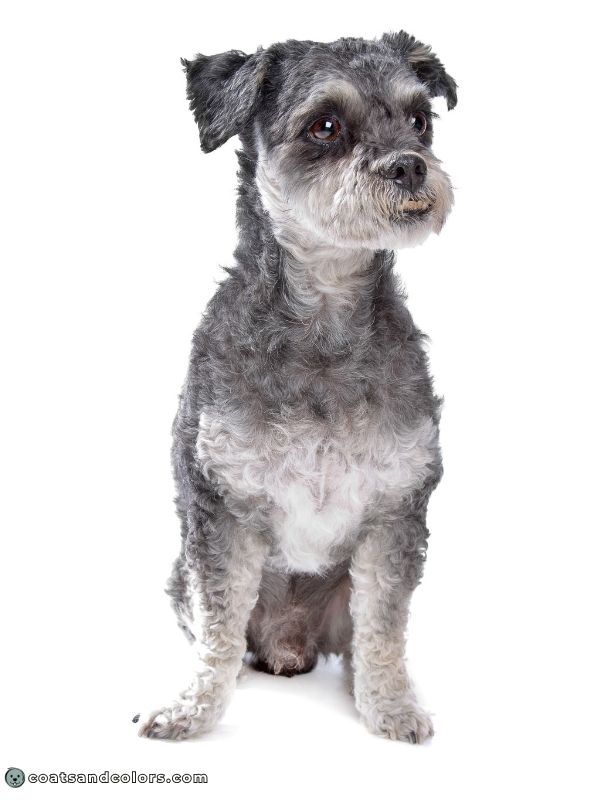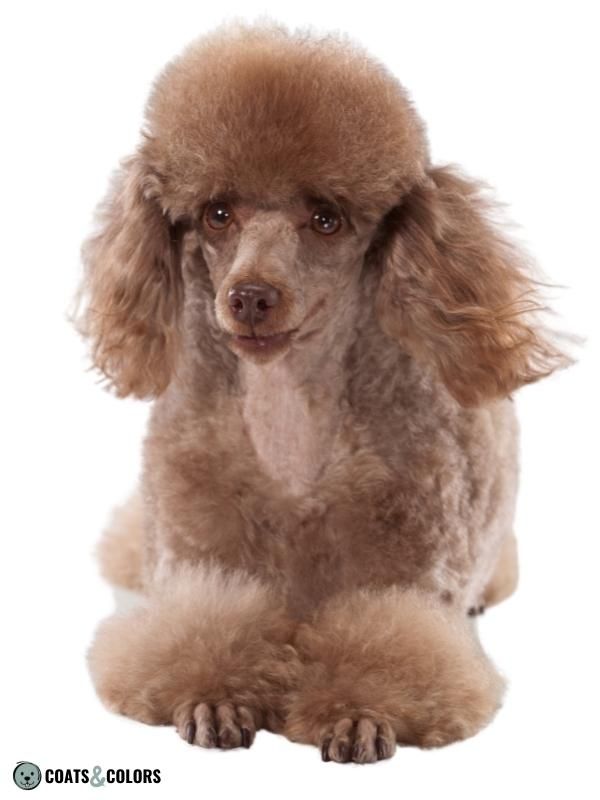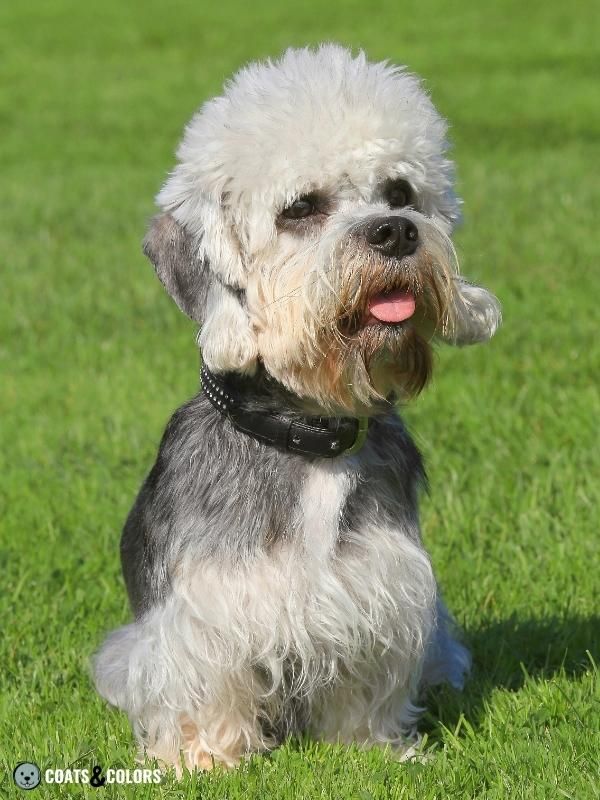Progressive graying causes a dog’s eumelanin pigment color to fade over time. Black fades to gray or silver while brown fades to a sandy beige or reddish cream color.
What is Progressive Graying?
In some dog breeds, puppies that were born with regular black or brown eumelanin pigment will fade to a lighter and paler shade over time. This is called progressive graying or progressive fading.
Graying usually starts in young puppies but can take up to several years. Dogs that start fading very early usually fade more quickly and turn out lighter when they are finished.

Progressive graying only affects bearded dogs.
Graying begins at the hair base and causes a gradual decrease of pigment density in the cortex of the growing hair shaft. The coat in many furnished breeds grows continuously. Shaving these dogs can speed up the perceived loss of color when we cut off all of the darker hair tips at once.

As a rule of thumb, eumelanin in any pattern will fade from black to blue or silver, and from brown to beige or to a pale cream color. Graying on dilute colors (blue and lilac) might not be as prominent at first glance (because these dogs already look grayish), but it will significantly lighten these colors.
Nose and skin pigment will not fade and keep their original color.
This way, we can distinguish a gray dog that was born gray and always had a gray nose from a gray dog that was born black and still has its black nose.

Many tan point Poodles also have faded tan markings. Phaeomelanin doesn’t seem to be affected in all cases, but the influence of fading on phaeomelanin intensity remains unclear[1].

The Graying Locus
The potential allele causing a pigment-fading phenotype is thought to be found at the theoretical G locus. But the “graying gene” has not been identified with certainty yet. So for now, we don’t know what mechanism is responsible for color fading in some bearded dog breeds.
One candidate for explaining graying is the KITLG gene on dog chromosome 15. In a recently published study, variation in KITLG seemed to be associated with pigment intensity along the hair shaft, phaeomelanin intensity in some breeds, but also with color variation in eumelanin-based Poodles[2].
But for now, we can only theorize how graying works from a breeder’s perspective. Progressive graying seems to be an incomplete dominant trait that causes a dose-dependent effect on all eumelanin in a dog’s coat.
Dogs with a g/g genotype don’t develop graying and keep their original color.
Dogs with a G/g genotype will fade slowly and only to some degree.
Dogs with a G/G genotype will fade quicker and more dramatically.
Since this is a dominant trait, a dog can not be a carrier without actually expressing graying. But graying will only affect dogs with furnishings and at least some eumelanin in their coat.

Graying will not be visible in dogs with smooth-faced coat types. And some patterns might be able to hide if a dog has graying. Think of extensive white spotting or solid red coats in clear sable or recessive red phenotypes.
Some long-haired dogs with a graying factor are said to sometimes get a lighter hair base even without furnishings. But any dog that has graying (even if they can’t express it) can still pass on G to their offspring, if they are in fact G/G or G/g.
Graying Examples
The coat pigmentation of dogs with progressive graying lightens as a dog reaches adulthood.
But this process can take some time and sometimes takes years until complete. In some cases, the coat will even periodically get darker when new hair growth happens. Usually, puppies are born with normal pigment (“black born gray“), but some can have lighter paws or a lighter muzzle even at birth.
Solid Coat Colors
Many dog breeds with graying have a solid dark coat color. This happens either from being dominant black (KB/-) or, in some rarer cases, from being recessive black (ky/ky a/a), e.g. in Pumis.

Interestingly, in breeds with dominant black, the hidden pattern on the A locus can temporarily become visible during the graying process, e.g. as faint tan markings on the muzzle or reddish hair on the back.
Dogs with a solid coat color and graying can be found in Poodles, Labradoodles, Bedlington Terriers, Briards, Kerry Blue Terriers, or Pyrenean Shepherds.


Usually, a black coat will fade to blue or silver, and a brown coat will fade to beige or café au lait. Dogs with only one copy of graying will fade less dramatically.

Areas with a shorter coat, like the ears or tail, can hold pigment better and appear darker than leg furnishings or a fluffy topknot. But the range of colors caused by fading is pretty variable. Minimal graying is sometimes perceived as “bad pigment” since it only loses some of its rich and full color.


Graying & White
Many dogs with fading pigment have white markings, e.g. Bearded Collies, Spanish Water Dogs, Portuguese Water Dogs, or some parti-colored Poodles.


Graying & Masks
In dogs with an Em allele, , the muzzle does not appear to fade as much as the rest of the coat. This results in a gray phenotype with a blackish mask or a sandy beige coat with a brownish mask.
This might just be a theory, but it can be observed in many breeds with both graying and masks, e.g Kerry Blue Terrier, Bouvier des Flandres, Briard, Tibetan Terrier, or Pyrenean Shepherd.


Graying & Sabling
Dogs with heavy sable shading have enough eumelanin so that graying can be visible. Examples can be found in breeds like Irish Wolfhound, Tibetan Terrier, Löwchen, or Skye Terrier.





Some sable dogs only have dark pigment on their ear tips which will turn gray over time.

Graying & Brindle
Many dog breeds with progressive graying also come in brindle.
But since all of the affected breeds are long-haired, wiry, or curly, the darker stripes in their coat give a less distinct pattern compared to short-haired dogs. And graying obscures a brindle pattern even more.
Brindle with graying is very common in breeds like Skye Terriers, Bouviers, Glen of Imaal Terrier, Deerhound, or Irish Wolfhound.

Graying & Tan Points
On a tan point pattern, the eumelanin will fade to gray or beige shades. Often, the tan markings seem to fade, too. This can leave a dog with very pale tan markings and a very faded base color.
Some dogs with a tan point pattern and graying are Poodles (the Poodle breed calls tan points “phantom“), Cesky Terriers, Bedlington Terriers, or Dandie Dinmont Terriers. Some lines of US Miniature Schnauzers also show graying in their dorsal coat, their tan is already very pale at birth.


Graying & Saddle Tan
In dogs with a saddle pattern and graying, the tan markings expand while the saddle gets lighter at the same time. Prominent examples of dogs with a faded saddle are Yorkshire Terriers.
Some other examples are Otterhounds, Lakeland Terriers, Griffon Nivernais, Petit Basset Griffon Vendéen, Australian Silky Terriers, or Grand Basset Griffon Vendéen.

Graying & Merle
Typical breeds with progressive graying are not breeds that traditionally come in merle. But in some crosses like Aussiedoodles, lurchers, or terrier mixes these traits can meet.
A classic merle pattern causes a mixture of fully pigmented and diluted patches, mainly affecting eumelanin. Graying will cause the once fully pigmented areas to fade and make any merling less distinct or barely visible. This can create a hidden merle situation and requires sensible breeding choices.

Graying Look-Alikes
Not all dogs with blue or gray coats got their color from progressive graying:
- Dilution causes dogs to be born with a diluted coat color and diluted skin and nose pigment.
- Low phaeomelanin intensity in A locus patterns can look very grayish, in Schnauzers.
- Atypical merle sometimes causes a uniform grayish color instead of a more patchy merle pattern.
- Domino and Grizzle cause pale hair roots, less eumelanin and it lightens phaeomelanin. The actual phenotype depends on a dogs original pattern but many dogs with agouti domino look grayish.

Dog Breeds with Progressive Graying
Graying is present in many bearded dog breeds:
- Australian Silky Terrier
- Australian Terrier
- Bearded Collie
- Bedlington Terrier
- Bergamasco Shepherd Dog
- Biewer Terrier
- Bolonka Zwetna
- Bouvier des Flandres
- Briard
- Cairn Terrier
- Catalan Sheepdog
- Cesky Terrier
- Dandie Dinmont Terrier
- Deerhound
- Glen of Imaal Terrier
- Grand Basset Griffon Vendéen
- Griffon Nivernais
- Havanese
- Irish Wolfhound
- Jack Russell Terrier
- Kerry Blue Terrier
- Lagotto Romagnolo
- Lakeland Terrier
- Lhasa Apso
- Löwchen
- Old English Sheepdog
- Otterhound
- Parson Russell Terrier
- Petit Basset Griffon Vendéen
- Poodle
- Polish Lowland Sheepdog
- Portuguese Water Dog
- Puli
- Pumi
- Pyrenean Shepherd
- Sealyham Terrier
- Skye Terrier
- South Russian Shepherd Dog
- Spanish Water Dog
- Tibetan Terrier
- Yorkshire Terrier
Learn More
Links
[1] Slavney AJ, Kawakami T, Jensen MK, Nelson TC, Sams AJ, Boyko AR (2021) Five genetic variants explain over 70% of hair coat pheomelanin intensity variation in purebred and mixed breed domestic dogs. PLoS ONE 16(5): e0250579. https://doi.org/10.1371/journal.pone.0250579
[2] Weich K, Affolter V, York D, Rebhun R, Grahn R, Kallenberg A, Bannasch D. Pigment Intensity in Dogs is Associated with a Copy Number Variant Upstream of KITLG. Genes. 2020; 11(1):75. https://doi.org/10.3390/genes11010075
Image Credits
© dpcrestock/yayimages.com
© eriklam/yayimages.com
© Mohan Nannapaneni/pixabay.com
© Adrienn Molnar/pixabay.com
© mariakbell/canva.com

Hi! I’m Steffi. I am a biologist and a big time dog nerd. You are curious about coat color genetics? You’ve come to the right place! Read more.








2 thoughts on “G Locus – Progressive Graying”
Comments are closed.